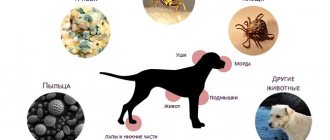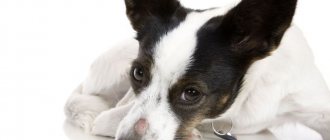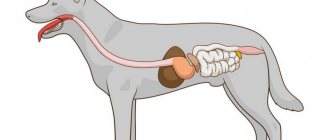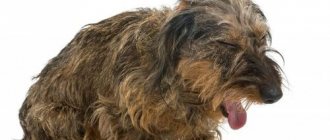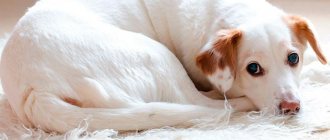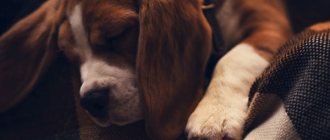- Types of lichen in dogs Symptoms of lichen in dogs Diagnosis of dermatophytosis in dogs Treatment of lichen
Ringworm in dogs, or dermatophytosis, is a common disease of dogs caused by fungal flora - dermatophytes belonging to the genera Microsporum or Trichophyton, tropic to keratin - that is, eating keratin, which makes up the hair, claws, and surface layer of the skin. The fungus usually lives on an infected dog but can survive in the environment for up to 18 months. Additionally, some dogs may carry the spores and not show any skin lesions. Lichen is a zooanthroponotic disease, that is, common to dogs and humans - dermatophytes can be transmitted to owners, especially people with reduced immunity, the elderly and children.
Dogs often become infected through contact with cats. Infection is also possible through contact with other dogs and with care items that contain fungal spores. Infection is possible when digging in the ground (in the case of Microsporm gypseum, which is a saprophyte and retains spores in the soil for a long time).
Types of lichen in dogs
There are three species of dermatophytes that cause skin diseases in small animals: Microsporum canis, Microsporum gypseum and Trichophyton mentagrophytes. Microsporum canis is the most common cause of dermatophytosis in dogs.
Depending on the type of fungus that causes lichen, it may be microsporia or trichophytosis. A very common popular name is also ringworm in dogs, sometimes it is even considered a certain type of ringworm, but this is incorrect, ringworm is not a medical name, since fungi parasitize on fur or hair, “cutting off” small areas - the hair breaks off grounds.
The most common cause of lichen is the fungus Microsporum canis, the second most common pathogen is Microsporum gypseum, which lives in the soil.
In human dermatology, there is a fairly broad classification of skin lesions - weeping, shingles, pityriasis versicolor, pityriasis rosea and others are distinguished, depending on the cause of the lesion, the presence of secondary pathologies, and so on. Ringworm is also mentioned as a popular name. This classification is not applicable in canine dermatology. If your dog's lesion is weeping and itchy, it most likely is not lichen.
There is an opinion that only ringworm in a dog is dangerous for humans - in fact, as already mentioned, such a diagnosis does not exist in principle; any fungal disease caused by the species listed above can be contagious to humans. There are also a number of other fungal diseases in dogs that will not be considered ringworm.
Symptoms of the disease
The classic picture of dermatophytosis (lichen) is single or numerous ring-shaped skin lesions, with hair loss, peeling in the center and the formation of crusts along the periphery, usually not accompanied by itching. The lesions may increase in size and merge with each other. The skin most commonly affected is the scalp, ears, paws and tail.
In dogs, a peculiar course of dermatophytosis has been described with the formation of kerions - single protruding nodular lesions on the head or paws, often with fistulous tracts. Extensive lesions on the trunk and abdomen may also occur, with a strong inflammatory component, redness of the skin and itching, the formation of a scab and fistulous tracts. Some dogs may have swollen lymph nodes.
Clinically, dermatophytosis can be very similar to a bacterial skin infection (pyoderm) or demodicosis, as well as some autoimmune diseases, so the diagnosis is never made based on clinical signs alone.
This disease most often affects young dogs under the age of one year. The appearance of dermatophytosis in older dogs is usually associated with the presence of other serious diseases, such as cancer or hyperadrenocorticism, or with inadequate use of hormonal anti-inflammatory drugs. Yorkshire Terriers and Pekingese have an increased susceptibility to this disease and are more likely to develop severe infection.
Symptoms of lichen in dogs
The first signs of dermatophytosis are most often areas of hair loss (formation of alopecia). A rash and the formation of scales may appear at this site. As a rule, there is no itching. The disease can be either localized (one or several areas of lesions) or generalized, with hair loss over a significant area of the body, with extensive skin lesions in the form of scaly, reddened areas (erythema) of a round shape. A symptom of lichen may simply be thinner hair than usual, especially in long-haired breeds - their hair does not necessarily fall out with lichen.
An indirect symptom will also be the appearance of pink spots without itching in people who come into contact with the dog, or similar areas of lost (“clipped”) hair in other pets.
Before you suspect your dog has lichen, it is worth determining where she could have contracted it. If a new pet has recently arrived at home, including a cat or kitten, or the dog has started visiting places where there are many other animals, the likelihood of becoming infected with lichen increases significantly. There is a breed predisposition in Yorkshire Terriers.
Other forms of manifestation of lichen in dogs can be kerion (nodular lesions, often on the face or limbs), onychomycosis (claw lesions), pseudomycetoma (deep nodular lesions).
If areas of lost hair appear, you should contact a veterinary clinic to rule out ringworm and other diseases that may have a similar clinical manifestation.
Ringworm in dogs
Content
- What is ringworm in dogs?
- Symptoms
- Diagnostics
- Treatment
Ringworm in dogs (dermatophytosis) is a superficial fungal skin disease that can also affect humans, but not all types of dermatophytosis are contagious to humans.
The most common pathogens belong to the genera Microsporum and Trichophyton. The fungus is transmitted by spores that can fly in the air and spread to household items (the spores are quite stable and can survive up to 1.5 years in the environment). As a rule, people with weakened immune systems are susceptible to this disease: pregnant women, children, the elderly, or people with underlying diseases that weaken the immune system. The fungus gets onto healthy skin tissue and begins to multiply. What symptoms of ringworm in a dog should you pay attention to first? The latent period of the disease, on average, lasts about 10-14 days, depending on the type of lichen. Only after this the clinical manifestation of the disease becomes noticeable.
- Itching most often in the affected area
- Noticeable superficial skin lesions in the form of discoloration (redness), hair loss (alopecia), peeling
- The spot gradually enlarges, new lesions appear
- Miliary dermatitis (similar to insect bites)
- Other forms of manifestation of lichen in dogs can be kerion (nodular lesions, often on the face or limbs), onychomycosis (claw lesions), pseudomycetoma (deep nodular lesions)
In most cases, skin lesions occur on the pet's paws, lower abdomen and face. If you notice similar symptoms of lichen in a dog, you must contact a veterinary clinic for further diagnosis and treatment.
What is the diagnosis for this disease?
- Wood's lamp examination (the lamp shines with ultraviolet light, in which SOME types of lichen will give a positive test glow with light green light)
- Trichoscopy (examination of animal hairs under a microscope)
- Cytology (presence of changes in the cellular structure of the skin, in the presence of spores)
- Sowing animal hair from the affected area onto a nutrient medium. (long study time - 2 weeks)
- PCR test (production time - 2 days)
Treatment
Treatment of lichen in dogs is long (about 4-6 weeks) and labor-intensive. Therapy consists of the systemic use of antimycotic drugs, such as: Itroconazole/fluconazole, terbinafine, ketoconazole, griseofulvin. And also the use of local therapy, in the form of rinsing lotions or shampoos: Imaverol, Liverazol, 2-4% chlorhexidine, miconazole, ketocanazole.
It is mandatory to thoroughly clean the apartment with a vacuum cleaner using disposable bags and then change the filter to clean the ventilation holes. And treat the apartment with chlorine-containing solutions at least 2 times a week (Liverazol/Imaverol dilution solution).
An animal is considered healthy if two negative cultures are detected at one month intervals.
Vaccines are not effective in either preventing or treating dermatophytosis in dogs.
The article was prepared by doctors from the Department of Dermatology “MEDVET” © 2015 SEC “MEDVET”
Diagnosis of dermatophytosis in dogs
Diagnosis of lichen in dogs is quite difficult, since no method can fully guarantee that dermatophytosis is excluded. The primary diagnostic method most often involves using a Wood's lamp, in the light of which hairs and spores affected by lichen will glow green. However, not all strains (varieties) of fungi cause lichen. will glow. If there is a glow, we can usually assume that the lichen is confirmed, but we must not forget that the glow may be false, for example, if there are residues of any creams or ointments on the fur. Most often, both if the Wood's lamp gives a positive result and a negative one, it is necessary to perform trichoscopy. This method involves examining wool under a microscope, on which fungal spores can be seen.
In some cases, it is necessary to take a culture for dermatophytes. The same method is also used to check before the end of treatment, since even a small number of spores that will not cause clinical symptoms, but remain on the fur, after the end of treatment can cause a relapse.
Kerion and pseudomycetoma require histopathological examination (i.e., excision of an area of affected tissue for further examination).
Symptoms and signs
The disease does not manifest itself immediately; after infection, it takes from 3 days to 3 months before the first symptoms appear. First, the pathogen enters the animal’s skin and releases toxins and enzymes that cause peeling of the skin. At this stage, dermatophytosis is invisible.
The fungus then invades the hair follicles and destroys them, causing hair to fall out. Horny scales and dried pus become visible on the skin. At first it is noticeable only in a small area, then it grows and gives rise to new lesions.
If the pathogen penetrates the skin, it will cause deep inflammation, and the accumulating pus will form an abscess. Hard bumps will appear in place of the fallen fur. If you press on them, it will hurt your pet.
The first patches of baldness usually appear on the face - around the eyes and ears. Hair loss is possible on the paws or withers. The rate of spread of bald spots is influenced by the type of pathogen, the immunity of the animal, and the conditions of its detention.
The coat undergoes changes throughout the body. At first, she looks normal, even if patches of baldness have already formed. Then the hairs become dull, become brittle, and fall out more often. The fur appears to be dirty and matted. Some owners think that poor quality food or infrequent bathing is to blame, so they delay treatment.
Some types of dermatophytosis cause itching. Usually it is weak - the pet itches a little more often than usual, without much diligence. Basically, he tries to catch the bald areas. It’s worse if the animal scratches the skin furiously until it bleeds. A secondary infection gets into the wounds, and the weakened immune system can no longer cope with it.
In general, the dog behaves as usual, the appetite remains the same. Only if dermatophytosis is complicated by an abscess or severe itching does the animal refuse food and water and become apathetic.
What is dermatophytosis?
Dermatophytoses are infectious diseases of keratinized tissues (skin, hair, nails) caused by fungi of the Microsporum, Trichophiton or Epidermophiton species.
In everyday life, all these diseases are called lichen.
If lichen is not noticed in time, this fungal disease can affect the dog for a long time. And not only her. Another insidious thing about deprivation is that it, unlike most other diseases that affect animals, can be transmitted to humans.
In scientific language, such fungal diseases are called zooanthroponotic. Other animals can also become infected with them, not only domestic ones, but also wild ones.
Therefore, the likelihood of your dog becoming infected during a walk is quite high. If there is also a cat living in the house and periodically walking in the yard, it can also bring the fungus, especially since this disease in the first stage can be asymptomatic.
There are several types of dermatophytoses, similar in symptoms:
- ringworm;
- trichophytosis;
- microsporia;
- favus.
All of them are characterized by the appearance on the animal’s skin of areas with signs of flaking, accompanied by loss or brittleness of the hairs of the coat.
The process continues with inflammatory processes on the skin, sometimes with purulent discharge. If nothing is done, these consequences of pathology can develop into a disease that will be very difficult to cure.
The risk group includes individuals with weakened immune systems, those recovering from other diseases, and those who are often in contact with stray animals.
Paradoxically, frequent use of shampoos when washing a dog weakens the protective properties of the skin. This does not mean that you need to stop using shampoos; it is simply advisable to purchase products that are less irritating to the skin.
